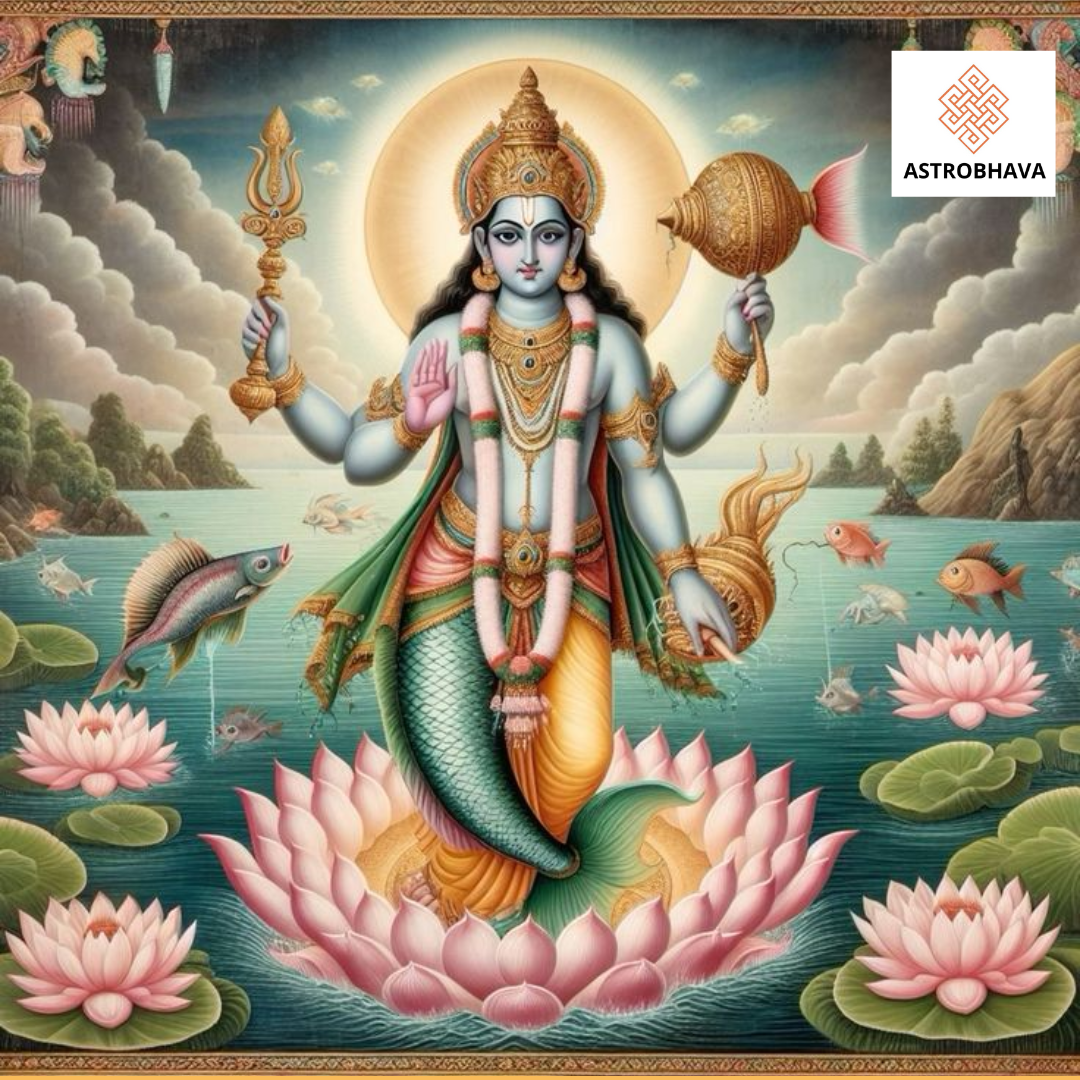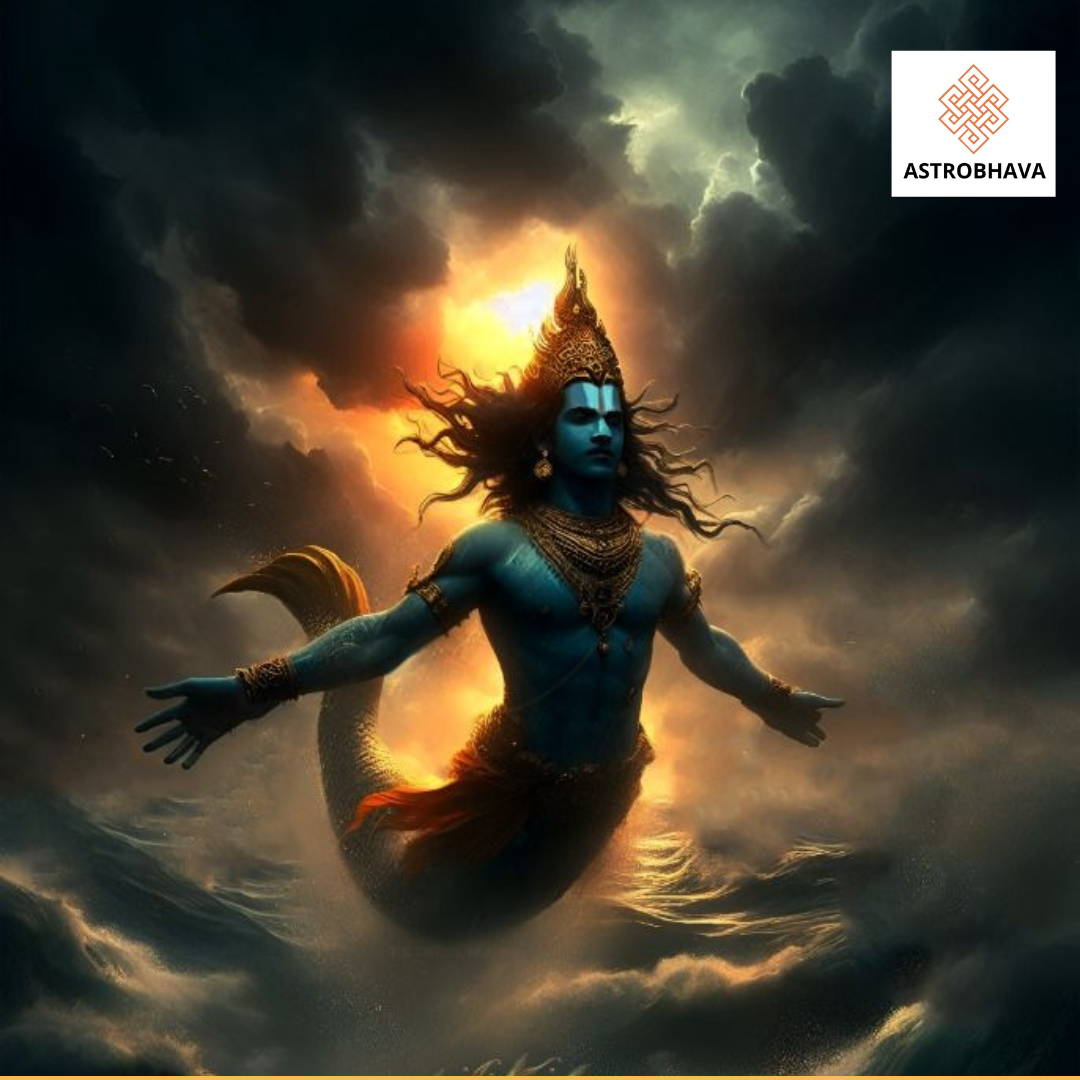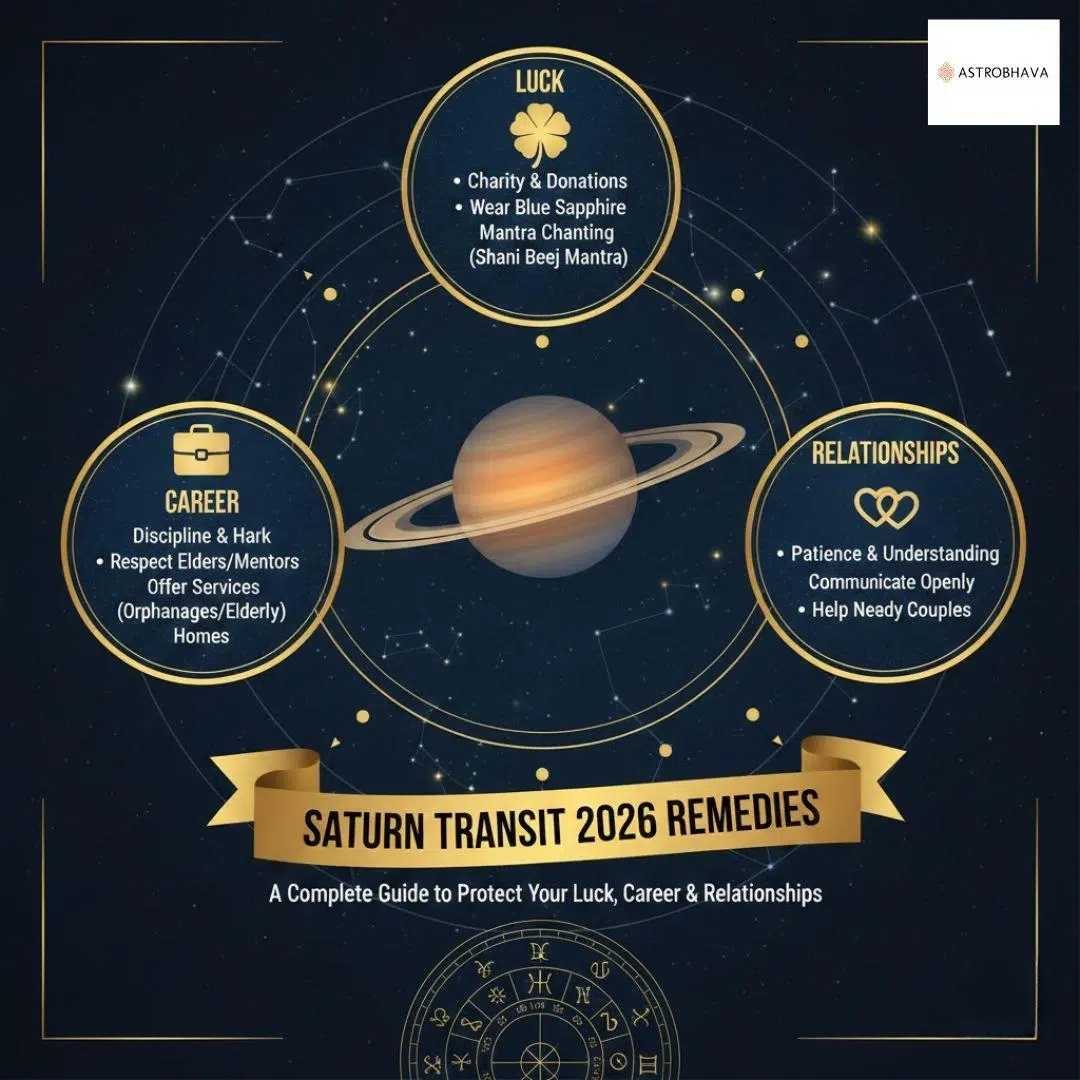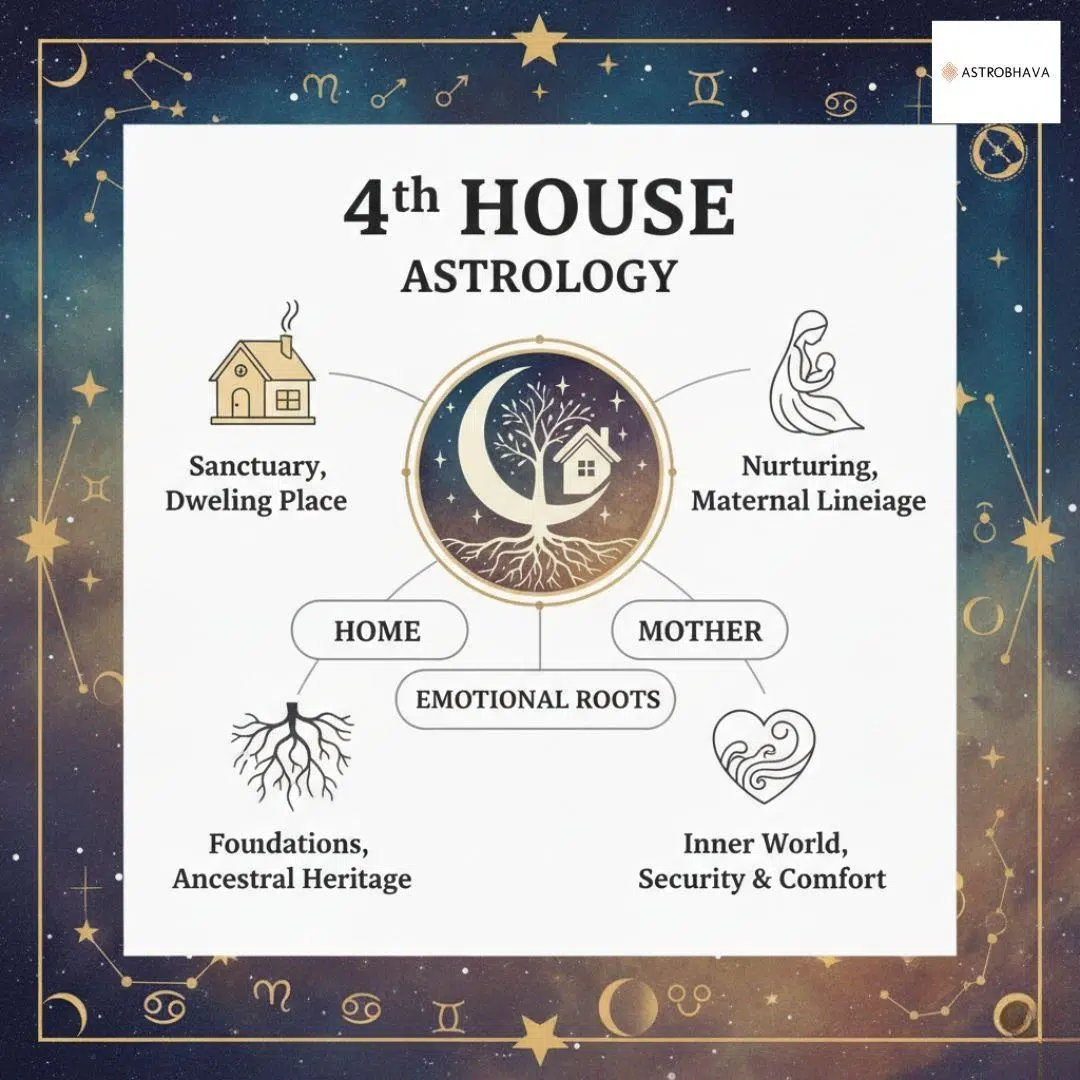Unveiling the Matsya Avatar Story: Lord Vishnu’s 1st Incarnation

The Matsya Avatar Story stands as the cornerstone of Lord Vishnu’s divine incarnations in Hindu mythology. As the first of the ten primary forms of Lord Vishnu, also known as the Dashavatara, the Matsya Avatar carries deep symbolic meaning and presents an early glimpse of Vishnu’s constant role in the preservation of the universe. Through the Matsya Avatar Story, we see not only divine intervention but also an eternal message about the importance of knowledge, protection, and the cyclical nature of creation and destruction.
What is the Matsya Avatar?
The Matsya Avatar Story revolves around the idea of Vishnu’s first incarnation as a fish. The word “Matsya” itself is derived from Sanskrit, meaning “fish.” According to the Matsya Avatar Story, Vishnu incarnated as Matsya in response to a catastrophe that threatened to erase all life and sacred knowledge from the Earth.
As the Matsya Avatar story goes, a demon named Hayagriva, who had stolen the Vedas (the sacred texts of Hinduism), plunged the world into darkness by hiding them beneath the waters. The Vedas, being the essence of divine knowledge, were crucial to the spiritual well-being of all living beings. Without them, humanity would be left in ignorance and chaos.
To restore the balance of the universe, Vishnu took the form of Matsya, a giant fish. In this incarnation, he guided a massive boat, carrying the sages (Rishis) and the Vedas, through the turbulent waters of a great flood. As the floodwaters rose, Vishnu, in the form of a fish, guided the boat to safety, ensuring that life and knowledge were preserved.
The Matsya Avatar thus represents the saving grace of the divine, stepping in during moments of cosmic distress to restore the balance of the universe and preserve essential wisdom for the future of humanity.
Historical Background of the Incarnation of Vishnu and Dashavatara
The Matsya Avatar marks the beginning of the Dashavatara—the ten incarnations of Lord Vishnu. The Dashavatara is a pivotal aspect of Hindu cosmology, illustrating how Vishnu incarnates in different forms to restore cosmic balance whenever the world is threatened by chaos, ignorance, or evil.
While Matsya Avatar is the first incarnation, the sequence of the Dashavatara follows a path that connects Vishnu’s divine interventions throughout the ages. Each form represents an evolutionary step in cosmic order:
- Matsya Avatar (Fish) – Saving the Vedas from a flood.
- Kurma Avatar (Tortoise) – Supporting the churning of the ocean.
- Varaha Avatar (Boar) – Rescuing the Earth from the demon Hiranyaksha.
- Narasimha Avatar (Man-Lion) – Defeating the demon king Hiranyakashipu.
- Vamana Avatar (Dwarf) – Subduing the demon king Bali.
- Parashurama Avatar (Brahmin with an axe) – Eradicating the corrupt Kshatriya rulers.
- Rama Avatar (Prince of Ayodhya) – Restoring dharma by defeating Ravana.
- Krishna Avatar (The Divine Cowherd) – Offering wisdom through the Bhagavad Gita and defeating evil forces.
- Buddha Avatar (The Enlightened One) – Teaching compassion and non-violence.
- Kalki Avatar (Future incarnation) – A prophesied avatar that will appear to destroy evil at the end of the current age.
Through the Matsya Avatar Story, Vishnu’s role in the creation, maintenance, and destruction of the universe becomes evident. It shows how the divine protects and nurtures knowledge, truth, and righteousness across all ages.
What Was the Purpose of the Matsya Avatar?
The purpose of the Matsya Avatar was multifaceted, deeply rooted in the preservation of knowledge, life, and cosmic order. It served as the first incarnation of Lord Vishnu, who incarnated as a fish to protect the world during a time of great calamity. Below are the key purposes of the Matsya Avatar:
1. Protection of the Vedas (Sacred Knowledge)
The most immediate and critical purpose of the Matsya Avatar was to preserve the Vedas, the sacred texts containing divine knowledge. According to the Matsya Avatar Story, the demon Hayagriva stole the Vedas and submerged them in the ocean, plunging the world into darkness and ignorance. Without the Vedas, the knowledge of dharma (cosmic law and order) would have been lost, leaving the universe vulnerable to chaos. Lord Vishnu incarnated as Matsya, a giant fish, to retrieve the Vedas and restore the essential wisdom for the well-being of humanity.
“Seek the blessings of Lord Ram- Book Rama Homa now”
2. Safeguarding Life
Another significant purpose of the Matsya Avatar was to protect life itself during a devastating flood. In the myth, Vishnu, in his Matsya form, guided a massive boat, which carried not only the Vedas but also the sages (Rishis) and seeds of all plant and animal life. As the floodwaters rose and threatened to wipe out all living beings, Vishnu ensured that life would continue by preserving the genetic material of every species on the boat. Thus, the Matsya Avatar symbolized the continuity of life even during times of great destruction.
3. Restoration of Dharma (Cosmic Order)
The Matsya Avatar played a role in restoring dharma, the universal moral order that governs the balance of life. The theft of the Vedas and the disruption of the natural order represented a grave violation of dharma. By restoring the Vedas and protecting the sages, Vishnu, in his Matsya form, ensured that the teachings of righteousness, truth, and justice would not be lost. This was not just a physical rescue but a restoration of moral and spiritual integrity to the world.
4. Demonstration of Vishnu’s Role in Cosmic Preservation
As the first incarnation of the Dashavatara, the Matsya Avatar set the stage for Vishnu’s ongoing role as the preserver of the universe. This incarnation demonstrated that Vishnu’s mission is to protect and restore order whenever the world is in danger. Whether through the preservation of sacred texts, the protection of life, or the restoration of dharma, the Matsya Avatar highlighted Vishnu’s divine responsibility to maintain cosmic balance.
5. Symbolic Significance of Water and the Fish
The Matsya Avatar in Matsya Avatar story also carries symbolic meanings related to the elements. Water is often associated with the primordial state of existence, and in Hinduism, it is seen as the source of life. Vishnu’s appearance as a fish in the waters symbolizes both the fluidity of life and the eternal cycle of creation, preservation, and destruction. The fish, as an aquatic creature, signifies adaptability, survival, and the capacity to navigate through the ever-changing currents of existence.
6. Divine Intervention in Times of Crisis
Lastly, the Matsya Avatar exemplifies the principle of divine intervention. The narrative shows how Vishnu steps in to protect and save creation during times of extreme peril. When everything seems lost, and humanity is on the brink of destruction, Vishnu’s incarnation brings hope, order, and a new beginning. This underscores the belief that divine forces always work to restore equilibrium, no matter how dire the circumstances.
In essence, the Matsya Avatar served as a cosmic rescue mission. It preserved knowledge, safeguarded life, restored righteousness, and showcased Vishnu’s enduring role as the protector of the universe
How Did the Matsya Avatar End?
The Matsya Avatar came to an end once the floodwaters subsided and the boat, carrying the Vedas and sages, reached the peak of Mount Meru. As the water receded, the world was saved, and life began anew. With his purpose fulfilled, Vishnu’s Matsya Avatar dissolved, marking the completion of this divine intervention.
It is said that upon the conclusion of the Matsya Avatar, Vishnu returned to his original divine form and prepared for his next incarnation, Kurma, where he would assume the shape of a tortoise. The end of Matsya Avatar represents not just the restoration of order, but also the cyclical nature of life and the ongoing process of divine intervention in the world.
Matsya Japa: The Chanting of Matsya Avatar’s Name
Matsya Japa refers to the repetition of mantras or the chanting of Lord Vishnu’s name in his Matsya Avatar form. This practice is believed to bring protection, clarity, and spiritual growth. Devotees engage in Matsya Japa to invoke the divine blessings of Vishnu and seek his guidance in overcoming challenges, especially those related to ignorance or turmoil.
“Invoke the blessings of Lord Matsya: Start your Matsya Japa now”
Chanting the sacred names of Matsya Avatar is thought to purify the mind and soul, offering a sense of tranquility and helping to achieve spiritual elevation. For those looking to connect with Vishnu’s first incarnation, Matsya Japa serves as a powerful tool for meditation and inner peace.
The Importance of Matsya Japa
- Spiritual Benefits
Chanting the name of Matsya brings several spiritual benefits, such as the purification of the mind, the removal of negative energies, and the cultivation of inner peace. Regular chanting helps to center the mind and focus the thoughts on the divine, helping the practitioner attain dhyana (meditation) and bhakti (devotion). - Invoking Protection and Guidance
Since the Matsya Avatar is associated with protection, especially during times of calamity, chanting his name through Matsya Japa is believed to provide divine protection from disasters, harm, and negative influences. This japa invokes the presence of Lord Vishnu, ensuring that the practitioner is guided through difficult situations with wisdom and strength. - Connection to Cosmic Order (Dharma)
Matsya Avatar was the protector of the Vedas, the sacred knowledge that sustains cosmic law (dharma). By chanting his name, devotees align themselves with the divine order and seek to restore balance in their lives. The japa helps strengthen the connection between the individual soul and the cosmic soul, bringing harmony and a deeper understanding of one’s spiritual path. - Purification of Past Karma
Just as Vishnu, in his Matsya form, helped save the knowledge of dharma from destruction, chanting his name is said to purify past karmic imprints. It is believed that the practice of Matsya Japa can help cleanse the practitioner of past sins and lead them toward moksha (liberation from the cycle of rebirth). - Development of Focus and Concentration
The repetitive nature of Japa aids in developing dharana (concentration), which is an essential aspect of spiritual practice. As practitioners chant the name of Matsya, their mind is focused solely on the divine, reducing distractions and allowing for deep meditation.
Matsya Homa: Ritual Offering to Lord Vishnu
Matsya Homa is a sacred fire ritual dedicated to Vishnu in his Matsya Avatar form. In this ritual, offerings are made into the sacred fire, and mantras are recited to invoke Vishnu’s protection and blessings. Performing Matsya Homa is believed to remove obstacles, purify negative energies, and align oneself with divine wisdom.
“Experience the divine energy of Matsya Homa: Schedule your ritual now”
It is an ideal practice for those seeking a deeper connection with the divine, particularly those who wish to ensure the preservation of knowledge and righteousness in their lives. The ritual also serves as a way to invoke blessings for success, prosperity, and protection from natural disasters or spiritual challenges.
Benefits of Matsya Homa
Performing Matsya Homa is believed to bring a host of spiritual, emotional, and material benefits. These include:
a. Protection from Dangers and Calamities
Just as the Matsya Avatar saved the world during the flood, performing this ritual provides protection from disasters, misfortunes, accidents, and negative energies.
b. Financial Prosperity
The ritual is also a way to invoke financial prosperity. By aligning oneself with Lord Vishnu’s divine energy, the devotee attracts wealth, success, and abundance in their life.
c. Spiritual Purification
The offerings into the fire symbolize the purging of negative thoughts, emotions, and karmas. The Matsya Homa helps cleanse the devotee’s mind, body, and soul, leading to overall spiritual purification.
d. Enhanced Knowledge and Wisdom
As Matsya Avatar protected the Vedas, performing Matsya Homa enhances one’s access to divine wisdom, knowledge, and spiritual understanding. This ritual helps to align the practitioner with higher spiritual truths.
e. Strengthened Relationships and Family Harmony
The Matsya Avatar represents the preservation of life and wisdom, and this ritual strengthens relationships within the family, encouraging unity, harmony, and mutual understanding.
Matsya Puja: Worship of the Matsya Avatar
Matsya Puja is a form of worship where devotees honor Lord Vishnu in his Matsya Avatar form, seeking divine blessings for knowledge, prosperity, and spiritual growth. This puja involves chanting sacred hymns, offering flowers, incense, and other sacred items to the deity, and performing various rituals to please Lord Vishnu.
“Seek protection and prosperity: Book your Matsya Puja today”
The Matsya Puja is particularly beneficial for those looking to overcome ignorance, seeking clarity in their personal or professional lives, and wishing to attain wisdom and inner peace. By invoking the divine through puja, devotees receive the blessings of Vishnu to protect them from worldly suffering.
Significance of Matsya Puja
Matsya Puja is a way of honoring Lord Vishnu’s first avatar and acknowledging the protection and guidance provided during times of calamity. The worship of Matsya is considered especially beneficial for those seeking:
- Protection from Natural Disasters: Matsya is known for saving life from a massive flood, and hence, worshipping him can offer protection from natural calamities, particularly floods.
- Wisdom and Knowledge: As the protector of the Vedas, Matsya symbolizes the preservation and dissemination of divine knowledge. Worshipping him is believed to help devotees attain spiritual wisdom and clarity of thought.
- Overcoming Difficulties: Just as Matsya helped humanity survive the deluge, devotees seek his blessings during challenging times, believing that his divine presence can help them navigate through life’s obstacles.
- Purification: Water, as symbolized by the Matsya Avatar, is considered purifying. Through Matsya Puja, devotees seek to purify their minds, bodies, and souls, ridding themselves of negative energies and influences.
Conclusion
The Matsya Avatar Story is a profound tale of divine intervention and cosmic balance. Through this first incarnation, Lord Vishnu showed the world that no matter how great the flood of chaos or ignorance may be, there is always a way to restore knowledge, righteousness, and life. The story of Matsya Avatar continues to inspire millions of devotees, offering them solace, protection, and wisdom.
If you’re seeking deeper spiritual insight, guidance, or personalized astrological solutions, visit Astrobhava today. Let our expert astrologers help you navigate through life’s challenges by harnessing the power of the Matsya Avatar and other divine forces.
FAQs
- What is the Matsya Avatar?
The Matsya Avatar is the first incarnation of Lord Vishnu, where he took the form of a fish to rescue the Vedas from a great flood and protect the sages. - What was the purpose of the Matsya Avatar?
The primary purpose of the Matsya Avatar was to preserve the Vedas, safeguard life, and restore cosmic order by guiding the boat through the floodwaters. - How did the Matsya Avatar end?
The Matsya Avatar ended when Vishnu guided the boat to safety, with the waters receding and the Vedas, sages, and lifeforms protected. Vishnu then returned to his divine form. - What is Matsya Japa?
Matsya Japa refers to the chanting of sacred mantras associated with Vishnu’s Matsya Avatar. It is practiced for spiritual growth, protection, and divine guidance. - What is Matsya Homa?
Matsya Homa is a fire ritual performed to invoke the blessings of Vishnu in his Matsya Avatar form, purifying the devotee and ensuring protection and prosperity.
Categories
- 10th House meaning
- 12th house astrology
- 12th House Moon meaning
- 1st house in astrology
- 2025 astrology
- 2025 festivals
- 2025 planetary movements
- 27 nakshatras
- 2nd house astrology finance
- 2nd house in astrology
- 2nd house in astrology explained
- 3rd house in astrology
- 4th house in astrology
- 9th house moon astrology
- abundance mantra
- Antardasha
- aries personality
- aries traits
- aries zodiac sign
- ascendant in astrology
- astro guide
- astro predictions 2025
- astro remedies
- astro tips
- Astrobhava
- Astrobhava astrology
- Astrobhava blog
- astrological effects
- astrological guidance
- astrological love compatibility
- Astrological love languages
- astrological planets
- Astrological Remedies
- astrology
- astrology 2025
- astrology 2026
- astrology 2nd house meaning
- astrology basics
- astrology benefits
- astrology calculator
- astrology career path
- astrology career prediction
- astrology compatibility
- astrology consultation
- astrology for business
- astrology for wealth
- astrology gemstones
- astrology guide
- Astrology Guides
- astrology houses
- astrology houses guide
- astrology insights
- astrology love guide
- astrology lucky color
- astrology predictions
- astrology remedies
- astrology remedies for job
- Astrology Remedies for Wellness
- astrology rituals
- astrology solutions
- astrology soulmate signs
- astrology sun planet
- astrology tips
- auspicious yogas
- Bhagavad Gita Jayanti
- birth chart
- birth chart analysis
- birth chart planets
- birth chart reading
- birth star matching
- business astrology
- business partnership astrology
- business success astrology
- career astrology
- Career Astrology & Personal Growth
- career astrology remedies
- career by nakshatra
- career growth remedies
- career stagnation remedies
- color astrology
- communication astrology
- communication planet
- compatibility chart
- Cosmology
- daily mantras
- Dasha
- dasha period calculator
- Dasha system
- Dhanu Sankranti 2025
- divine blessings
- dosha
- dosha remedies
- dreams interpretation
- dreams meaning
- Ekadashi benefits
- Ekadashi rituals
- Ekadashi vrat
- emotional astrology
- emotional compatibility
- emotional growth astrology
- emotional healing
- entrepreneurial astrology
- Festivals & Vedic Rituals
- financial astrology
- fire sign aries
- first house meaning
- fourth house meaning
- Gaja Kesari Yoga
- Gaja Kesari Yoga benefits
- gemstone astrology
- gemstone benefits
- Gita Jayanti 2025 astrology
- Gita Jayanti astrology
- hindu astrology
- Hindu calendar 2025
- Hindu fasting
- Hindu Festivals
- Hindu festivals 2025
- Hindu festivals astrology
- hindu rituals
- Homa and Fire Rituals (Yagna)
- home and family astrology
- horoscope
- horoscope 2025
- horoscope analysis
- horoscope colors
- horoscope correction
- horoscope guide
- horoscope insights
- horoscope matching
- horoscope reading
- horoscope remedies
- horoscope yoga benefits
- Indian astrology
- insightful trade
- Japa
- job astrology
- Jupiter Moon yoga
- kundli matching
- kundli reading
- lagna in astrology
- Latcharchana remedies
- list of 27 nakshatras
- lord of nakshatra
- love astrology
- love horoscope
- love match astrology
- lucky color for zodiac signs
- lucky gemstones
- lunar rituals
- lunar signs
- Mahadasha
- Mahadasha Calculator
- mahadasha effects
- Mahadasha periods
- Mahadasha prediction
- Mahadasha remedies
- mahadasha results
- Makar Sankranti
- manifestation mantras
- Mantra
- mantra chanting tips
- mantras for success 2026
- Margashirsha puja
- Margashirsha Purnima 2025
- Margashirsha rituals
- Marriage Auspicious Day
- marriage matching
- match making astrology
- Mercury direct 2025
- mercury direct meaning
- Mercury in astrology
- Mercury planet
- Mercury Retrograde
- Mercury Retrograde dates
- Mercury Retrograde effects
- mindset improvement
- Moon and profession
- Moon astrology
- Moon astrology insights
- Moon effects in astrology
- Moon house meaning
- Moon in 10th House
- Moon in 11th House
- Moon in 12th House
- Moon in 6th House
- Moon in 6th House effects
- Moon in 6th House remedies
- Moon in 7th House
- Moon in 7th House astrology
- Moon in 7th House effects
- Moon in 7th House love
- Moon in 7th House marriage
- Moon in 7th House meaning
- Moon in 7th House remedies
- Moon in 8th House
- moon in 8th house love
- moon in 8th house marriage
- moon in 9th house
- moon in 9th house effects
- Moon in Astrology
- moon in eighth house effects
- Moon in Eleventh House meaning
- moon in ninth house meaning
- Moon in Sixth House astrology
- Moon in tenth house career
- moon meaning
- Moon placement
- Moon placement in 7th House
- nadi astrology
- Nakshatra and Mahadasha
- nakshatra astrology
- nakshatra calculator
- nakshatra career guide
- nakshatra characteristics
- Nakshatra compatibility
- nakshatra guide
- nakshatra healing
- nakshatra job compatibility
- Nakshatra Lord
- nakshatra matching for marriage
- nakshatra meaning
- Nakshatra Remedies
- nakshatra ruler
- nakshatras
- natal chart analysis
- natal chart meaning
- numerology
- online astrology tool
- Panchami Festival
- partnership compatibility
- past karma
- past karma astrology
- personality in astrology
- Pilgrimage
- planet mercury meaning
- planetary dasha calculator
- planetary insights
- planetary mahadasha
- planetary periods
- planetary remedies
- planetary retrograde
- planetary transits 2025
- planets houses
- positivity rituals
- powerful astrology solutions
- powerful mantras
- Progency
- Puja & Rituals
- puja remedies
- Purnima 2025
- relationship astrology
- Relationships
- religious dates India
- remove career blockages
- retrograde meaning
- rudra puja
- Rudraksha and gemstone
- sankranti 2025
- Sankranti puja
- sankranti rituals
- Saphala Ekadashi 2025
- Saturn japa
- Saturn remedies
- saturn transit 2026 remedies
- shani dev mantra
- Shani dosha
- Shani japa benefits
- Shani mantra
- shani mantra 2026
- shani mantra benefits
- shani remedies
- Spiritual Astrology
- spiritual benefits
- spiritual growth
- Spiritual Guide
- spiritual healing
- Spiritual Practices and Chanting
- spiritual remedies
- Spiritual Rituals and Personal Empowerment
- spiritual significance
- Spiritual Tools & Personal Growth
- Spiritual Wellness and Protection
- Spirituality and Rituals
- Spirituality or Vedic Rituals
- star sign compatibility
- success mantras
- sun and zodiac signs
- Sun in Astrology
- sun in horoscope
- sun planet effects
- sun planet meaning
- sun power in astrology
- temple rituals
- transit astrology
- twin flame astrology
- Twin Flame Astrology Signs
- twin flame compatibility
- twin flame signs
- Utpanna Ekadashi 2025
- Utpanna Ekadashi dates
- Utpanna Ekadashi rituals
- Utpanna Ekadashi significance
- Vaikuntha Dwar
- Vaikuntha Ekadashi 2025
- Vastu Tips
- Vedic Astrology
- vedic astrology tools
- Vedic remedies
- Vivaah Panchami
- Vivaah Panchami Puja
- Vivaah Panchami Rituals
- Vivaah Panchami Significance
- vrat guide
- vrischik sankranti puja
- vrishchik rashi
- Vrishchik sankranti
- yantras
- yoga effects
- zodiac astrology
- zodiac colors meaning
- zodiac compatibility
- zodiac lucky colors
- zodiac moon traits
- zodiac relationships
- Zodiac Signs










